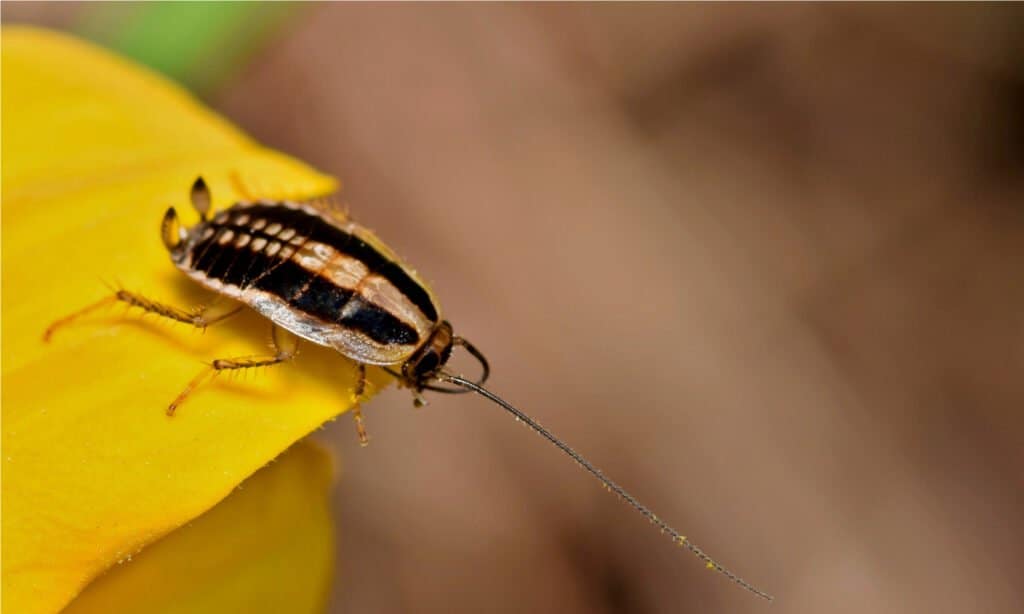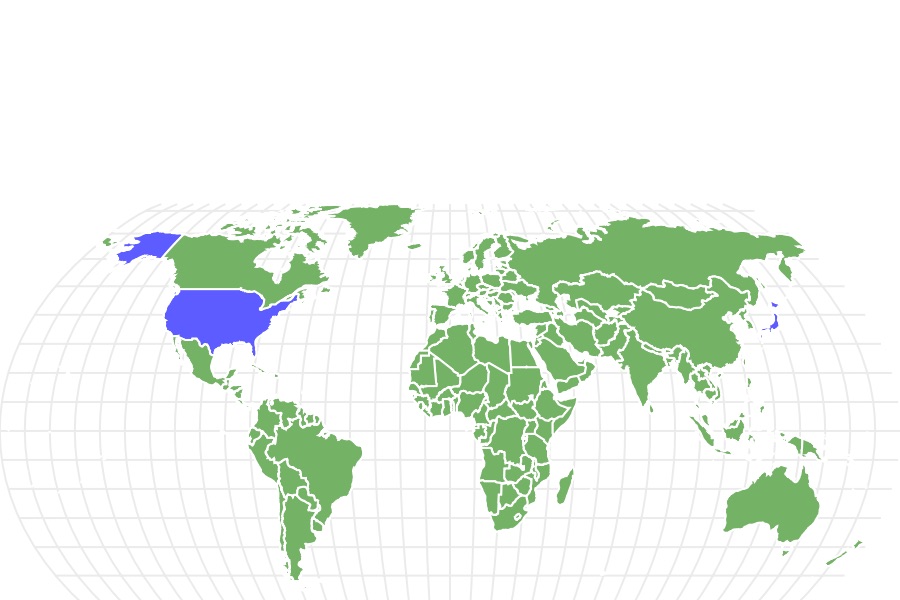Asian Cockroach
Blattella asahinai
Originally discovered in Japan
Advertisement
Asian Cockroach Scientific Classification
- Kingdom
- Animalia
- Phylum
- Arthropoda
- Class
- Insecta
- Order
- Blattodea
- Family
- Ectobiddae
- Genus
- Blattella
- Scientific Name
- Blattella asahinai
Read our Complete Guide to Classification of Animals.
Asian Cockroach Conservation Status
Asian Cockroach Facts
- Prey
- Decaying plant and animal matter
- Name Of Young
- Nymph
- Group Behavior
- Colony
- Fun Fact
- Originally discovered in Japan
- Biggest Threat
- Extermination by humans
- Most Distinctive Feature
- Body length wings
- Other Name(s)
- Roach
- Gestation Period
- 19 days
- Litter Size
- 35-40 eggs per egg case
- Diet
- Omnivore
- Type
- Insect
- Common Name
- Roach
- Number Of Species
- 1
- Location
- North America and Japan
- Group
- Cockroach
View all of the Asian Cockroach images!
“The Asian cockroach was first discovered on the Japanese island of Okinawa.”
Cockroaches have made their way onto every continent in the world, even Antarctica. They live everywhere humans live, and in many areas where people are absent. There are a shocking number of roach species around the world—almost 5,000. One species, the Asian cockroach, was first described only a few decades ago, in the 1980’s.
First seen in Japan, the Asian cockroach now lives throughout the southeastern United States. They’re almost always mistaken for the incredibly common German cockroach, though there are subtle differences between the two species. Fortunately, Asian cockroaches aren’t nearly as big of a problem as are German roaches.
The Asian cockroach comes from a long line of roach relatives, about 350 million years worth. That’s right; cockroaches were around when dinosaurs roamed the earth. And, back then they looked almost exactly the same as they do today. Out of all the world’s insects, roaches just may be the best at surviving. The Asian cockroach is no exception; they continue to spread throughout the warm, humid regions of the United States.
4 Incredible Asian Cockroach Facts!
- Asian cockroaches originally came from Japan
- They look almost identical to German cockroaches
- Females carry their egg cases around until the eggs are ready to hatch
- Asian roaches eat anything they can find, even feces
Asian Cockroach Species, Types, and Scientific Name
The scientific name of the Asian cockroach is Blattella asahinai. First classified in 1981 in Okinawa, the Asian cockroach can now be found throughout the southeastern United States. They’re limited to warm areas with plenty of damp soil and leaf litter. Scientists believe Asian cockroaches are closely related to German cockroaches; the two are almost identical.
Appearance: How to Identify Asian Cockroaches
Asian roaches grow to between ½ and ¾ of an inch long as adults. Nymphs are smaller, and have no wings. Males and females are very similar in appearance, the only real difference being that males are slightly bigger, and have longer wings. Asian cockroaches follow the general format of all cockroach species; two antennae, six legs, and segmented bodies.
Compared to other roaches, the antennae of the Asian cockroach are relatively short. Shield-like structures called pronotums protect their heads; two vertical, dark brown bands mark the pronotum. After the head comes the thorax, or second body segment. Both the wings and first pair of legs are attached to the thorax.
The Asian roach’s abdomen is its longest body segment; both the second and third pairs of legs are attached to it. Like most species of roach, sharp spikes cover the Asian roach’s legs; they’re used for traction on slippery surfaces.

A
sian Cockroach nymph (Blattella asahinai) preening its antennae on a yellow flower. They are usually dark brown, reddish-brown, or shiny black in color with a glossy body.©Brett Hondow/Shutterstock.com
Life Cycle: How to Identify Asian Cockroach Eggs
Asian roaches have three main life stages; egg, nymph, and adult. Eggs aren’t freestanding, like chicken or snake eggs, though. Instead, they’re kept in hard, rectangular cases called ootheca. Females carry the ootheca around with them, attached to their rear ends, until the eggs inside are ready to hatch.
Each egg case contains between 35-40 eggs which incubate for around 19 days. When they hatch, the newborn baby roaches are pale white with soft bodies. They often huddle underneath the mother for a few hours directly after birth, until their exoskeletons harden up a little. Nymphs grow steadily for 60-70 days, molting and regrowing their skins as they get bigger.
After the final molt, the nymph becomes sexually mature and gains its adult wings. Females live longer in adulthood than males, but the average adult lifespan is between 50-100 days. In that time, female Asian roaches will produce just four egg cases.
Habitat: Where to Find Asian Cockroach
Unlike other species of pestilential roaches known for invading homes, the Asian cockroach actually prefers the outdoors. Like the Pennsylvania wood roach, the Asian roach prefers to live outside in natural settings. Asian cockroaches can most often be found in shaded, moist areas full of leaf litter or mulch. If conditions are right, they’ll stick to one area, and breed in that spot, until they’ve overrun the whole place.
Asian cockroaches were originally found only in Japan, but in recent decades they have increasingly been found in the southeastern United States. They’re a heat-loving species and tend to stick to areas with plenty of gardening and landscaping areas. So far, they’ve been reported in Florida, Georgia, Alabama, South Carolina, and Texas.
Diet: What do Asian Cockroaches Eat?
Like all cockroaches, Asian roaches are omnivores who specialize in detritus. They’ll eat just about anything they can find, though their predilection for the outdoors means they primarily eat leaf litter and rotting organic matter. However, Asian cockroaches are also fond of human food, which means that, when they do make their way into buildings, they can quickly cause problems.
Because Asian cockroaches are capable of flight, open doors and windows make excellent entrances to homes. Once inside, they’ll feast on everything from leftover food to pet waste. Outdoors, they’re found in compost bins, near piles of mulch, or in garden beds.
What Eats the Asian Cockroach?
These cockroaches are mostly nocturnal; they’re most active at dusk. Their nocturnal nature keeps them safe from predators that only hunt in the day like most birds of prey. However, not all predators go to sleep when it gets dark. Reptiles, amphibians, small mammals, and nocturnal birds all prey on Asian roaches.
Asian Cockroach vs. German Cockroach
When Asian cockroaches were first seen in the United States, they were mistaken for German cockroaches. The two look extremely similar, but there are important behavioral differences. The most extreme difference comes in the flight abilities of each species; German cockroaches can do no more than flutter their wings, while Asian roaches are capable of full flight.
To look at them, you would have a hard time telling which is which. But, there are a few distinguishing features. First, Asian roaches have longer, narrower wings. Females of both species carry their egg cases around with them, but the longer wings of the Asian roach obscure most of her egg case. In contrast, German cockroach egg cases are not hidden by wings.
Prevention and Extermination: How to Get Rid of Asian Cockroaches
Preventing an influx of these cockroaches may not be as easy as it sounds. They’re attracted to plant detritus of all kinds, which means they may take up residence in your garden, landscaping, or even your lawn. They don’t often come inside, though you should take care to screen any windows or doors to prevent entry.
If you have an infestation of these cockroaches outside your home, you should clean up any unnecessary leaf litter or accumulated mulch. Then, instead of using insecticide sprays or roach traps, opt for toxic pelletized baits spread out around the garden. If you do decide to use pellet bait, be sure that it’s not accessible to pets or children. Roach traps and insecticides are toxic to both humans and animals.
View all 192 animals that start with AThank you for reading! Have some feedback for us? Contact the AZ Animals editorial team.















